
Speed Circuit is a Formula I racing game published by 3M in 1971, and then republished by Avalon Hill in 1977.

Speed Circuit is a Formula I racing game published by 3M in 1971, and then republished by Avalon Hill in 1977.
Speed Circuit is a racing game for 2-6 players (with an option to add up to six more players). Drivers customize their cars and then race them on a variety of Formula I tracks.
The Avalon Hill edition includes: [1]
Each player starts with a car with a Start Speed of 40 mph, Acceleration and Deceleration of 20 mph, Top Speed of 140 mph, and 4 Wear Points. Each player has a pool of 5 points. [2] Using a pool of 5 points, each player spends 0, 1 or 2 points on each of those categories, resulting in:
The players select which of the three tracks to use, and how many laps each race will be. Start position is determined by start speed — the player with the highest start speed gets the inside lane front row start position. The second fastest start speed gets the middle lane front row, and so on. If two or more players have the identical start speed, their order is determined randomly. [3]
The players write down their speed for the first turn (their listed Start Speed) on their player log. A player can choose to increase their start speed by 20 mph, but risks stalling (rolling a 5 or a 6 on a die), which leaves them on the start line until the second turn. The drive can again try to increase start speed by 20 mph on the second turn, but a car that stalls two turns in a row is out of the race. The car in the lead moves first, moving 1 square ahead for every 20 mph of speed. The second car then moves, and so on. [3] A car cannot voluntarily leave the track if its path is blocked by another car — a collision results instead.
Once all players have had their first turn, each player secretly records their speed for the next turn, which can be the same as the previous turn, or increased in increments of 20 mph up to the maximum acceleration and Top Speed of the car, or decreased in increments of 20 mph up to the maximum deceleration of the car. Once again the lead car moves first, followed by each car in order. Once speeds have been revealed, cars must travel that speed, and cannot accelerate or decelerate to avoid a collision. [3]
To change the speed of the car, the player marks a new speed for the coming turn in accordance with the car's maximum acceleration and deceleration. The driver can exceed maximum acceleration by 20 mph, but risks engine damage. Similarly, the driver can exceed maximum deceleration by up to 80 mph, but depending by how much, may result in a loss of Wear Points, and may cause the car to "spin out" (come to a stop and be forced to start the next turn from a standing start). [3]
Speed limits are posted in corner spaces. In addition, a long arrow is drawn through each corner. Any car entering a space above the limit risks losing Wear Points, spinning out, or crashing out of the race. A car that follows an arrow through the corner from begeinning to end can take the corner at 20 mph above the speed limit without penalty. [3]
If a car starts the turn behind another car, both are on a straightaway, and the trailing car is going the same speed or less than the lead car, then the driver of the trailing car can elect to slipstream. The trailing car adds 20 mph to its speed if the lead car is moving at 120 to 160 mph, and adds 40 mph if the lead car is travelling 180 mph. [3]
If a car collides with another car, the car causing the collision spins out and must start the next turn from a standing start. The car that was hit continues the race with no penalty. [3]
The first car to cross the finish line is the winner. If two cars cross the finish line on the same turn, the car that travelled the furthest past the finish line is the winner. If both cars travelled the same distance, then the car that crossed the line first is the winner. [3]
Speed Circuit was originally designed and published by 3M in 1971. [4] [1]
Avalon Hill acquired the rights and Don Greenwood redeveloped the game before it was re-released in 1977 with six metal cars. Players could order six extra cars from Avalon Hill to enable games with up to twelve players, and could also order 15 additional tracks to supplement the three included in the game. [3] Avalon Hill re-released the game in 1989, replacing the metal cars with plastic cars.
In 1991, the German game company Klee produced a German-language edition. [1]
In 2016 UltraPro ran a Kickstarter [5] to publish a revision of the game under the new title Championship Formula Racing. [6] The new edition was subsequently published in 2017 and continues to be played in a number of Play-by-eMail and in-person events including new leagues based in Detroit [7] and San Marino. [8]
Games included Speed Circuit in its top 100 games of 1986, saying, "The tricky part is predicting what other drivers will do while you look for openings in the pack. Luck plays almost no role in this test of racing skills on three famous tracks." [2]
In Issue 6 of Games International , Pete Birks compared five of the most popular car racing games, and said of Speed Circuit that it "tries hardest to be realistic." Birks had several recommendation for best play, saying, "An entire article could be written on the optimal use of [corner] arrows (particularly on the nasty second and third bends on the Monaco track) but, put simply, use them when you can. Always look at least one turn ahead, and try to dominate the play. If you can get the inside line at a vital point in the game, the use of two wear points may be worthwhile." He also noted "A single error (often one down to guesswork when another player has a choice of speeds and you have to guess which one he will choose) can lose a player a game." [3]
In A Player's Guide to Table Games, John Jackson noted, "The advantage lies with the faster, inside cars, but outguessing your opponents in the corners — deciding when to stay on the outside and keep your speed up, when to cut inside, and when to use your wear allowance — is a real challenge." [9]

An open-wheel single-seater is a car with the wheels outside the car's main body, and usually having only one seat. Open-wheel cars contrast with street cars, sports cars, stock cars, and touring cars, which have their wheels below the body or inside fenders. Open-wheel cars are built both for road racing and oval track racing. Street-legal open-wheel cars, such as the Ariel Atom, are scarce as they are often impractical for everyday use.
Racetrack is a paper and pencil game that simulates a car race, played by two or more players. The game is played on a squared sheet of paper, with a pencil line tracking each car's movement. The rules for moving represent a car with a certain inertia and physical limits on traction, and the resulting line is reminiscent of how real racing cars move. The game requires players to slow down before bends in the track, and requires some foresight and planning for successful play. The game is popular as an educational tool teaching vectors.
A Formula One car or F1 car is a single-seat, open-cockpit, open-wheel formula racing car with substantial front and rear wings, and an engine positioned behind the driver, intended to be used in competition at Formula One racing events. The regulations governing the cars are unique to the championship and specify that cars must be constructed by the racing teams themselves, though the design and manufacture can be outsourced. Formula One cars are the fastest cars in the world around a race track, owing to very high cornering speeds achieved through the generation of large amounts of aerodynamic downforce. Due to the amount of braking force and the total cornering envelope of a Formula One car, Formula One drivers experience frequent lateral g-loadings in excess of five g and peak cornering forces of up to seven lateral g.
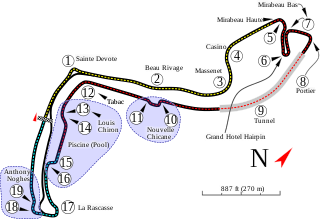
Circuit de Monaco is a 3.337 km (2.074 mi) street circuit laid out on the city streets of Monte Carlo and La Condamine around the harbour of the Principality of Monaco. It is commonly, and even officially, referred to as "Monte Carlo" because it is largely inside the Monte Carlo neighbourhood of Monaco.
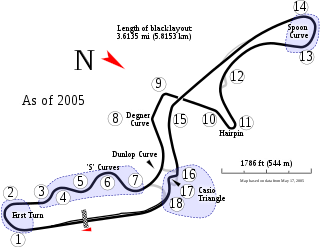
The Suzuka International Racing Course, more famously known as the Suzuka Circuit, is a 5.807 km (3.608 mi) long motorsport race track located in Ino, Suzuka City, Mie Prefecture, Japan and operated by Honda Mobilityland, a subsidiary of Honda Motor Co, Ltd. It has a capacity of 155,000.

Simulated racing or racing simulation, commonly known as simply sim racing, are the collective terms for racing game software that attempts to accurately simulate auto racing, complete with real-world variables such as fuel usage, damage, tire wear and grip, and suspension settings. To be competitive in sim racing, a driver must understand all aspects of car handling that make real-world racing so difficult, such as threshold braking, how to maintain control of a car as the tires lose traction, and how properly to enter and exit a turn without sacrificing speed. It is this level of difficulty that distinguishes sim racing from arcade racing-style driving games where real-world variables are taken out of the equation and the principal objective is to create a sense of speed as opposed to a sense of realism.
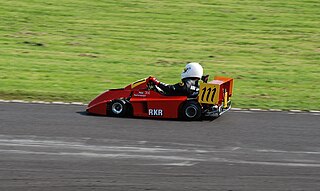
Superkart is a form of motorsport road racing that uses karts on long circuits.

Intercity Istanbul Park, also known as the Istanbul Racing Circuit or initially as the Istanbul Otodrom, is a motor sports race track in the Tuzla district of Istanbul, Turkey. Designed by Hermann Tilke, it opened on 19–21 August 2005. It has been called "the best race track in the world" by former Formula One Chief Executive Bernie Ecclestone, who held the managing rights of the circuit between 2007 and 2011. The circuit has been currently managed by the Turkish company Intercity since 2012.

Drifting is a driving technique where the driver intentionally oversteers, with loss of traction, while maintaining control and driving the car through the entirety of a corner. The technique causes the rear slip angle to exceed the front slip angle to such an extent that often the front wheels are pointing in the opposite direction to the turn. Drifting is traditionally done by clutch kicking, then intentionally oversteering and countersteering. This sense of drift is not to be confused with the four wheel drift, a classic cornering technique established in Grand Prix and sports car racing.

Formula D is a board game that recreates formula racing. It was designed by Eric Randall and Laurent Lavaur and was originally published by Ludodélire. The rights to the game passed to EuroGames with the collapse of Ludodélire, and were in turn acquired by Asmodée Éditions. When Asmodée released their new edition, the game's name was shortened to Formula D and its rules updated to include street and import racing.

Autódromo Internacional de Curitiba was a motorsports circuit located in Pinhais, Brazil. It has been host to the World Touring Car Championship, TC2000, Fórmula Truck and Stock Car Brasil racing. Until 2013 the circuit has also been host of the South American Formula 3 Series, namely the Formula 3 Sudamericana. The circuit also formerly hosted the Brazilian Formula Three Championship.
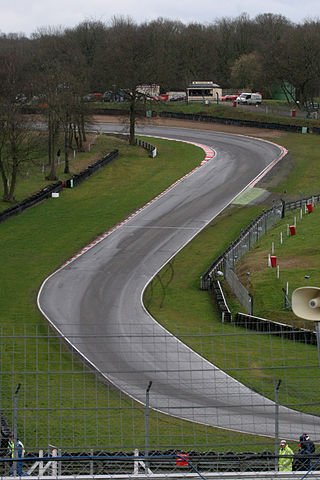
In motorsport, the racing line is the optimal path around a race course. In most cases, the line makes use of the entire width of the track to lengthen the radius of a turn: entering at the outside edge, touching the "apex"—a point on the inside edge—then exiting the turn by returning outside.

Al Unser Jr.'s Turbo Racing is a racing video game for the Nintendo Entertainment System console released in 1990. It is an adaptation of the 1989 Japanese-market Famicom game World Grand Prix - Pole to Finish, with the most notable changes being the addition of Unser as an in-game coach, the number of laps, sound and interface design. Therefore, the game remains based on the Formula 1 World Championship, despite Unser having never competed in it. This game features a season mode and two time trial modes. In season mode the player uses either Al Unser Jr. or a make-their-own-driver.
Satoru Nakajima F-1 Hero is a video game developed by Human Entertainment released for the Nintendo Entertainment System in 1990. It starred American IndyCar driver Michael Andretti, and featured the full sixteen-race schedule of the FIA Formula One World Championship circuit.

The Marina Bay Street Circuit is a street circuit around Marina Bay, Singapore, encompassing the planning areas of Downtown Core and Kallang.

Nakajima Satoru Kanshuu F1 Grand Prix is a 1991 Sega Mega Drive Formula One video game based on the career of Satoru Nakajima. Nakajima was the first full-time Japanese racer in the history of Formula One. In fact, this was the first game that Nakajima endorsed for a Japanese video gaming system. The entire 1991 Formula One season can be re-enacted with any of the notable contenders from the prestigious Formula One racing organization.

Alfa Romeo Racing Italiano, known in Europe as SCAR - Squadra Corse Alfa Romeo, is a racing video game for the PlayStation 2, Windows and Xbox. It was developed by Milestone srl and released in 2005.
The following is a glossary of terminology used in motorsport, along with explanations of their meanings.
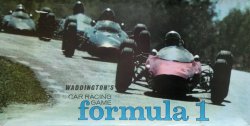
Formula 1 is a motor racing themed board game designed by John Howarth and Trevor Jones and originally published by Waddingtons of Leeds, United Kingdom in 1962.
F-1 Spirit is a series of Formula One-based racing video games developed and published by Konami starting on the MSX in 1987.